Both when you are prepping for a disaster and when you are in the middle of a survival scenario, finding food is a priority and a challenge. It becomes even more difficult during the winter when animals hunker down, and most plants go dormant for the winter.
That being said, there are certain plants that need to be harvested during the winter. Foraging for wild edibles requires a lot of knowledge, but plants like rose hips are an easy find in the winter. In this article we will cover where to find rose hips, how to harvest them, how to store them, and how to use them. This will get you more prepared for foraging the next few cold months.
Related: 15 Things That You Can Forage For In Winter
Finding This Little Gems
Rose hips are the fruit produced by rose plants. Yes, these are the same roses that you might have in your landscaping bed out front. As long as they have not been sprayed with chemicals and you do not cut off the flower, even landscaping roses will produce hips. However, in most cases people are heading out into the wild to harvest these little gems.
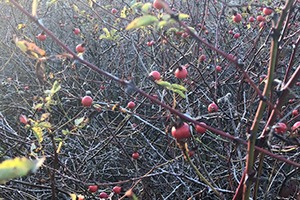 To find rose hips you are obviously searching for wild rose plants. These can be found in any moderate climate from Southern Australia all the way to Northern Canada.
To find rose hips you are obviously searching for wild rose plants. These can be found in any moderate climate from Southern Australia all the way to Northern Canada.
You just need to know where to look. Primarily you will find roses in open areas where they can get partial sunlight.
This includes fields, trails, roadsides, brush patches, and along the edges of clearings in the woods. They need some sun, but also like a little shade throughout the day. This balance where shady areas meet direct sun are perfect for roses.
Identifying Rose Hips
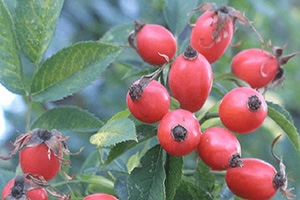 Rose hips form after the flowers lose their petals. In colder climates you can see them as early as August, and in warmer climates you can harvest them all winter long. You can find wild roses that are on vines and also in shrub form. They all have curved thorns. The leaves are elliptical with jagged edges and are opposite each other on the stem.
Rose hips form after the flowers lose their petals. In colder climates you can see them as early as August, and in warmer climates you can harvest them all winter long. You can find wild roses that are on vines and also in shrub form. They all have curved thorns. The leaves are elliptical with jagged edges and are opposite each other on the stem.
Their flowers are symmetrical and typically white or pink. Once the petals fall, the hips form in that spot. They are oblong fruits that are red or orange in color. They often have what look like hairs or strings coming out from the base of the fruit.
The fruit can be large and round or small and football shaped depending on the variety. For identification, try studying pictures of the leaves as this can distinguish the plant year-round. There are no poisonous look-alike plants for roses. In addition, there really is nothing else in nature that resembles rose hips. This makes identification relatively easy if you are new to foraging.
Harvesting
For harvesting, be sure your rose hips are red or orange. If they are still green, they are not ready to pick. The longer the fruit sits on the plant, the sweeter it gets.
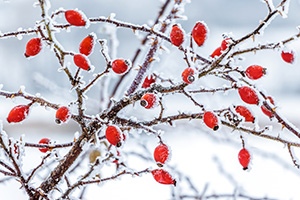
Just after the first frost is a good time to look for them. If they are a little wrinkled, those are the fully ripened fruits. They should come off the plant with a little tug. If they are tough to remove, they are likely not ready to harvest.
It should be mentioned that roses themselves can be harvested for prepping and survival purposes. You can use garden shears to remove the blossoms and avoid hurting yourself on the thorns.
It is best to harvest rose blossoms just after they open up and are still young. Older mature rose blossoms do not work as well for our purposes. It is especially important that you know the roses have not been sprayed with chemicals if you want to harvest the blossoms.
Related: Harvesting and Using Dandelion Roots – The Natural Detoxifier
Survival Food
The fruit from the rose plant can be eaten fresh for a nice boost in Vitamin C. They actually have one of the highest levels of Vitamin C of any plant found in nature. They are sweet and tart, much like their cousin the crab apple.
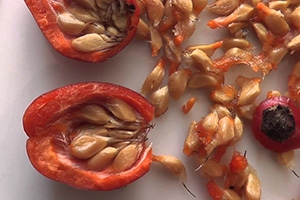 You can eat them fresh and whole for a quick snack. You can also just add the petals to a salad for a change in flavor and texture.
You can eat them fresh and whole for a quick snack. You can also just add the petals to a salad for a change in flavor and texture.
However, you need to cut them open and scoop out the seeds. The seeds have little hairs that can irritate your throat or stomach if consumed.
If you are infusing a dish or drink with rose hip flavor, just be sure to strain the liquid before consuming to get the seeds and hairs out.
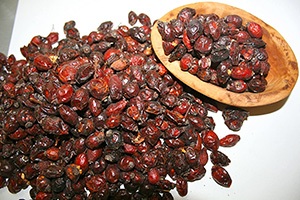 You can add dried rose hips to baking projects like cookies, or you can reduce them down into a sweet jam. Rose hips can be dried and ground into flour.
You can add dried rose hips to baking projects like cookies, or you can reduce them down into a sweet jam. Rose hips can be dried and ground into flour.
You can also use them to infuse nutrients and flavor into honey, vinegar, oil, or drinks like whiskey or wine.
Medicinal Uses For Rose Hips
Rose hips do have medicinal qualities making them ideal for survival. In addition to the high levels of Vitamin C, they have tons of antioxidants. You can make them into a tea or cook them down into a syrup.
They also make a great moisturizer, so they can be added to soaps, lotions, or lip balm. Rose hips can help with urinary tract infections, diarrhea, cramps, the flu, or just to boost your immune system. Let’s face it… we could all use a boost right now.
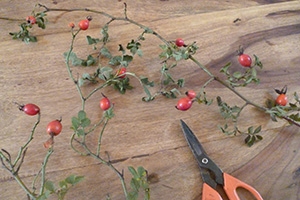 They can help with heartburn if eaten raw or made into a tea.
They can help with heartburn if eaten raw or made into a tea.
The petals can be used for a healthful replacement for bandages on an open wound. The stems of the rose can even be peeled and eaten or stripped into cordage.
If you choose to harvest the rest of the plant, there are plenty of additional uses. The petals are great for your skin with anti-inflammatory and moisturizing properties. The petals can be used for pretty much all of the same purposes as the hips such as infusing flavor and nutrients into other substances.
Preservation And Storage
You can eat rose hips fresh, cook them down into jams, add them to baking recipes, or infuse other products with them.
However, dried rose hips will last significantly longer. If you want to stockpile for prepping purposes, this is the way to go. Start by cleaning your rose hips and cutting off the step and blossom ends. Lay them out and let them dry for a few days. Then use a spoon to split them open and scoop out the seeds and hairs.
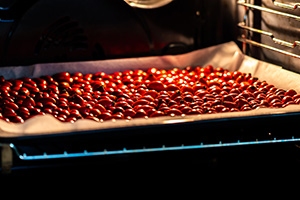
Once partially dried, spread them out on a baking sheet and set your oven on the lowest setting. Leave them in the oven for five to seven hours.
When done they should be completely dry and hard. When cool, put them in a food processor and pulse them until they are broken down.
You want them in small pieces, but not broken down into a powder. You can then transfer them to an air-tight container. If you store them in a cool, dry place they will last all year until you can harvest again. Just watch out for mold or insects.
Related: How to Dry Plums for Long-Term Storage Just Like Grandma
As you can see, rose hips can offer a tasty treat. They can also provide lots of different health benefits. During the winter months it can be difficult to find a wild source of Vitamin C and antioxidants. Rose hips can provide a good solution for this problem. The beautiful part is that roses come back every year.
If you find a good patch of roses and harvest the hips, you should be able to go back to that same spot every year at the same time and harvest again. Really, rose hips are the ideal wintertime wild edible. They are easy to identify, nutritionally valuable, and can be found in most of the world. Now get out there and give it a try for yourself.
You may also like:
 200 Pounds of Food With this Plant You Can Harvest in Winter
200 Pounds of Food With this Plant You Can Harvest in Winter
How to Make Bark Bread from a Tree that Grows on Almost Every Street in America (Video)
50 Low-priced Items That Will be Invaluable when SHTF
The Map That Shows You The Edible Trees In Your Neighborhood

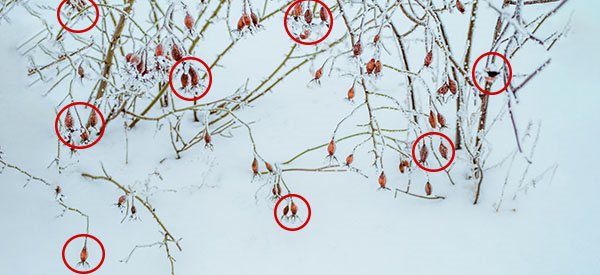













so just for clarity, if eating them fresh, you scoop out the seeds and throw them away because they irritate your stomach? So if eating fresh, you only eat the fleshy outer part?
Roses have been a well appreciated survival plant in many a European monastery herbal garden for centuries. Multi-functional too! A wild rose thicket creates a natural wicked defense barrier. The very same plant provides a beautiful table setting for a sweet rose tea party. Cheers!
Good knowledge to know, and high in vitamin c. But if you are down to eating rose hips to survive? I hate to tell you. But you got a lot bigger problems? But good to know!!
Hello WildKat. Yes please do not eat the seeds. You can also purée then cook and strain through cheese cloth. So in the old days sometimes natives where referred as itchy bums. So I looked up why. It ends up it was from eating rose hips and not taking out the seeds. The rose hip seeds also irritate the intestinal track heavily. I like rose hips in tea and they make a great jam..
Thank you, don’t need itchy bums, LOL
And, of course what do we have? 2 fountain roses and a rambler. All must be sterile because I have yet to see a hip. On the other hand, rose petals infused with pure lard make a great cream to fight bruises. https://herbs.org.nz/rose-a-medicinal-herb/
niio
Unfortunately there are no wild roses in our area although I cultivate a few. The best and most drought tolerant 1 for me has to be the McCartney or Cherokee rose. Mine has white flowers but can go practically all summer on just the natural rainfall from winter and the odd summer thunderstorm. I haven’t seen many hips on it but because it is so vigorous it has to be trimmed to keep it in line so maybe I’ve been cutting them off.
Hey Ginny,
We are fortunate where I am located in Northern Canada, The Property we have is covered in them and there are very few years when we don’t have an overabundance. As for some of the comments yes Rose Hips are to be a supplement especially for vitamin C or a last resort in a true survival situation. But people should know about them as even the Natives collected them in large quantities in case of hard times and to be used in medicine. I am lucky where I am at since we have good soil for being as far North as we are as we have a nice black topsoil and a mix of sand and clay at the lower sub soils instead of rock and stones. So even our trees here grow faster and larger compared to other areas I have lived and visited. We also get a lot of service berries, sugar plums (Saskatoon berries), blue berries, raspberries, strawberries including Indian Strawberries and other medicinal plants such as mullein, Joe Pye Weed and even naturally growing rye grasses etc. I have been lucky enough to find old Rhubarb stands where there use to be old homesteads. I always wondered how hard it would be to survive off the land in arid and semi-arid regions.
Ginny: Every chance they got, the goats would sneak thru the fence and attack the roses. Fountain roses grow so fast, and the goats only made them grow faster. But, no rose hips, any time. If you plant the seeds of the roses that do produce, you should get a variety that produces well. Maybe a thorny mess, as well, tho.
I saw this on survivopedia abd it looks good. I wish I knew this when we were farming! 🙂
https://www.survivopedia.com/why-you-need-to-use-thistle-for-food-and-medicine/?source=newsletter&utm_campaign=2020-12-17-Thistle-Food-Medicine&utm_source=survivopedia&utm_medium=email&utm_content=linktext
niio
But you will be fat and happy eating canna lilly while rose hipsters slowly starve.
I love rose hip tea for a wonderful change of pace. Leaves, flower petals, and even some roots are medicinal and tasty. If all i find are a few i rinse them and let them sit in a quart of boiling water. Take off heat and after 5 minutes add a green tea bag and heat till almost boiling and enjoy. A bit of honey is nice.
I have a patch of wild yellow roses I planted a few here nearly 30 yearsago. Near them are wild gooseberries then some wild red plums. Over the years each planting has spread a bit. Further from my home I planted cacti along a fence a dirt road. Many have taken root and with time i hope they will also spread. They also make edible pads and fruit.
ClergyLady: Gooseberries? I wish! But, wondering, do you think cactus flowers are good? They’re a close relative of the rose. niio
Mike: LOL, true! Just read a good one on suvivopedia on thistles. Wish I had known that while were were farming. Like the Carib said of their enemies, the best revenge is dropping them in the outhouse. https://www.survivopedia.com/why-you-need-to-use-thistle-for-food-and-medicine/?source=newsletter&utm_campaign=2020-12-17-Thistle-Food-Medicine&utm_source=survivopedia&utm_medium=email&utm_content=linktext
niio